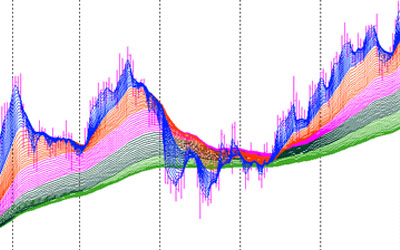Over the last few years, cryptocurrency artificial intelligence innovations have risen — merge the two and you have a formidable combination. Machine learning is set to be a game-changer for crypto trading due to its ability to make data-driven predictions.
But how exactly do the two work together, and which algorithm types are leading the way? Let’s take a look.

The Role of AI Crypto Trading
Trading has a reputation for complexity. Learning to trade is challenging, but cryptocurrency markets may be even more difficult to navigate than those of other commodities. While markets like the S&P 500 have a century or more of historical data (which can be used to make forecasts), the crypto market has only a few years of history.
Plus, it regularly faces unprecedented events and has featured more extreme price swings. Many cryptocurrencies have gone from valuable to worthless practically overnight (such as LUNA coin), while others have achieved returns of 5,000% or more in months.
Given the difficulty of trading in the crypto market, AI can play a crucial role in cutting through the noise to examine vast amounts of data and make forecast price activity.
Machine Learning
The AI that has received the most attention in recent years is large language models (LLM) such as GPT-4. However, other types of artificial intelligence have more potential for crypto trading.
While LLMs can understand text and generate answers, their reliance on textual input is less useful for quantitative datasets. This is where machine learning models come in.
Machine learning (ML) algorithms are trained on large datasets and can handle numerical data — and over time, they can recognize patterns. By using these algorithms, people can make better, more accurate trading decisions.
For instance, the AlgosOne solution is trained on vast datasets from various sources and in different languages. It uses ML algorithms to forecast future price movements and aid traders.
Top Cryptocurrency Machine Learning Algorithms
Now, let’s look at the most exciting machine learning algorithms for AI crypto trading.
Support Vector Machines (SVM)
Support vector machines are supervised learning algorithms. They label input and output data, which helps the AI to make connections between the inputs and outputs (and therefore predict which input could cause a particular output in the future).
SVMs are particularly adept at handling “noisy data” (data filled with irrelevant, meaningless information). Since the cryptocurrency market is infamously volatile and features a lot of price swings with little rhyme or reason, SVMs are a useful tool for cutting through this noise to identify underlying trends and patterns.
Semi-supervised Learning
We’ve already covered supervised learning. An alternative to this is unsupervised learning, which trains AI on unlabeled data. As a result, the machine learning algorithms must identify relationships by grouping the data together and finding connections.
However, there’s a third way: semi-supervised learning. This involves models that learn from a mixture of unlabeled and labeled data. This helps models to take some cues from the data without becoming overly reliant on pre-defined conclusions, offering the best of both worlds.
Graph Neural Networks
Although we mentioned that machine learning is good at analyzing the quantitative data associated with the crypto market, it’s generally better suited to tabular data (data in rows and columns) rather than graphs. Yet information on crypto markets tends to take the latter form.
Graph neural networks provide a solution. These networks are designed to interpret graphs, which is surprisingly tricky for algorithms since they tend to rely on the assumption that inputs are independent of each other (rather than linked). Another area of difficulty is that complex graphs can take different forms and feature different numbers of nodes (vertices on a graph).
This opens up a whole new area of analysis for cryptocurrency markets. For instance, graph neural networks can analyze graphs showing what traders are buying and selling from an exchange, then make predictions about how prices will react.
Random Forest
You may be familiar with decision trees from studying probability in mathematics classes. Random forests take this concept one step further, using multiple decision trees to make predictions. They’re “random” because they randomly select features from the data to make their predictions (with each tree taking a distinct approach).
Each decision tree makes its own prediction, and the final prediction used is the most common conclusion among the different trees.
Random trees can make better predictions than other algorithms since they solve the problem of overfitting (when the model adapts too well to noise in the data it’s given and can’t adapt to new data).
This is particularly powerful for making predictions over the long term. It could therefore be a good tool for traders who want to “HODL” and identify the cryptocurrencies that could stand the test of time rather than trying to predict price trends over the short term.
Generative Models
As touched on already, one of the most significant complications of analyzing crypto markets is the short history of the data. This limits the ability of many machine learning models to make accurate predictions — they may jump to conclusions based on patterns that seemingly exist in the data but don’t have enough historical basis to be truly reliable.
As their name suggests, generative models can generate data of their own. Once a programmer feeds them a dataset to train them, they can create new data that follows the same pattern. This is particularly powerful when combined with some of the other models outlined above, because the synthetic data made from generative models can be fed to other models and used to generate more accurate predictions.
There are a few types of generative models. For instance, generative adversarial neural networks (GANs) must “compete” with each other to create the best data. This is particularly useful for analyzing financial markets.
Revolutionizing AI Crypto Trading
Making sense of crypto markets will always be a challenging task, but machine learning algorithms are making it more achievable. However, depending on their goals, traders may want to focus on different machine learning algorithms. For instance, neural networks can predict short-term movements, while random forests are better for predictions over a long-term horizon.
Tradersdna is a leading digital and social media platform for traders and investors. Tradersdna offers premiere resources for trading and investing education, digital resources for personal finance, market analysis and free trading guides. More about TradersDNA Features: What Does It Take to Become an Aggressive Trader? | Everything You Need to Know About White Label Trading Software | Advantages of Automated Forex Trading








































